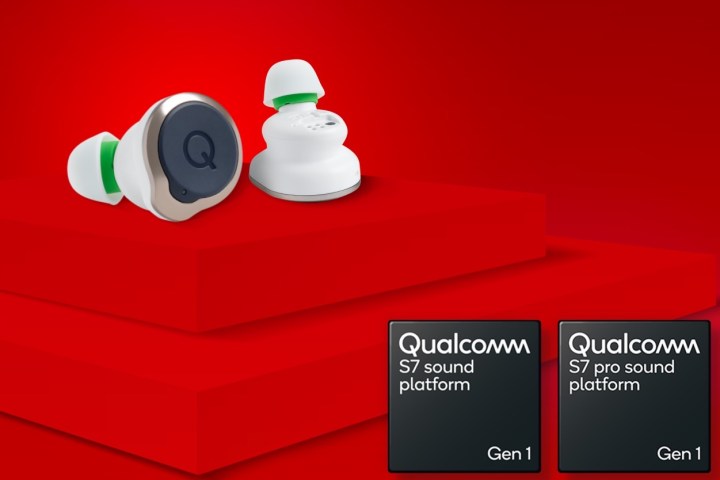
Qualcomm’s latest chips for wireless earbuds and headphones achieve what has long been impossible (or at least, very impractical) — they give these devices the ability to connect over standard Wi-Fi in addition to Bluetooth. This not only has the potential to significantly extend Bluetooth’s wireless range, but it also makes playback of lossless hi-res audio a possibility, and that’s something that Bluetooth’s limited bandwidth can’t do.
It’s expected that we’ll see the first products to use this technology as early as the end of 2023.
Micro-power Wi-Fi
The technology, which Qualcomm calls XPAN (expanded personal area network), uses micro-power Wi-Fi that’s built into its latest audio chip, the S7 Pro Sound Platform Gen 1. “Micro-power” is the key to making Wi-Fi for earbuds and headphones work. Traditionally, Wi-Fi has been very power-hungry and would have required a bigger battery than you’d normally be able to fit in a set of wireless earbuds.
Qualcomm claims its XPAN Wi-Fi is so power-efficient that it can stream 96kHz lossless audio for 10 hours using the same size of battery that previously could only run Bluetooth audio at 48kHz for the same period of time.
Greater range than Bluetooth
Having Wi-Fi connectivity in a set of earbuds or wireless headphones is great from a bandwidth point of view, but it can also play a role in wireless range. Bluetooth is usually limited to around 33 feet, unless you’re using a class 1 Bluetooth radio (which few earbuds and headphones have). It’s also poor when it comes to penetrating walls and other obstacles. But many of us have Wi-Fi networks that cover our entire home, either by using a single powerful Wi-Fi router or, increasingly, by using a mesh Wi-Fi system.
Qualcomm’s XPAN is designed to sense the quality of a Bluetooth connection, and switch it seamlessly to Wi-Fi as you reach the limits of Bluetooth range. That’s handy for listening to music uninterrupted, but it’s even more helpful when you’re on a phone or video call.
XPAN works with Wi-Fi 5, 6, 6E, and 7 networks on 2.4, 5, and 6GHz bands, which means that in corporate settings, it might allow you to roam anywhere that’s covered by your office Wi-Fi.
Massive bandwidth
Wi-Fi might be overkill for casual stereo listening, but XPAN’s bandwidth — up to 29 Mpbs — is almost 30 times bigger than Bluetooth, which opens the door to a lot of applications. With that kind of headroom, 24-bit/192 kHz lossless music streaming is easily achieved. In fact, it’s a high enough data rate that you could stream 16 channels of Dolby True HD, including Dolby Atmos.
Snapdragon Sound required
As compelling as these examples are, the first products to use the S7 Pro Gen 1 chipsets will only be able to use XPAN when paired with a Snapdragon Sound device. In this case, we’re talking about devices that use Qualcomm’s Snapdragon 8 Gen 3 mobile platform or its Snapdragon X Elite platform for PCs.
However, Digital Trends was told that XPAN could make its way into Bluetooth wireless speakers, where it could potentially be used to access Wi-Fi music streams from services like Apple Music and Amazon Music without needing a Snapdragon Sound device acting as an intermediary. It could also pave the way for additional wireless home theater products that compete with solutions from WiSA and Sonos.
Better ANC, transparency, and AI
While Wi-Fi for wireless earbuds and headphones feels like the big news for Qualcomm’s audio announcement, it’s only available on the company’s S7 Pro Gen 1 platform. But there’s also a non-pro version of the S7 platform too, and along with the S7 Pro, it has tons of other enhancements.
Qualcomm says it has increased the onboard AI capabilities of these chips 100-fold when compared to its S5 generation, which opens up a lot of potential for companies to create innovative audio-based experiences. Likewise, there’s six times more overall compute power.
The chips support Bluetooth 5.4, including compatibility with LE Audio and Bluetooth Auracast. Qualcomm says it has also improved its native active noise cancellation, which now includes an adaptive transparency mode. There’s also support for spatial audio and immersive, low-latency gaming audio.
The platform even extends into hearing enhancement through the use of personal sound amplification.
Editors' Recommendations
- Next-gen wireless headphones will get lossless hi-res audio with a little help from Qualcomm
- Qualcomm promises sub-20-millisecond latency for Bluetooth audio
- $2,199 Hed Unity Wi-Fi headphones are the first to offer lossless hi-res audio
- What is Snapdragon Sound? Qualcomm’s wireless audio brand fully explained
- Next-gen Qualcomm chips make wireless earbuds, headphones better for gaming and spatial audio


